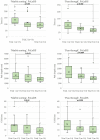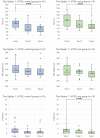Validation of the portable virtual reality training system for robotic surgery (PoLaRS): a randomized controlled trial
- PMID: 34873652
- PMCID: PMC9160149
- DOI: 10.1007/s00464-021-08906-z
Validation of the portable virtual reality training system for robotic surgery (PoLaRS): a randomized controlled trial
Abstract
Background: As global use of surgical robotic systems is steadily increasing, surgical simulation can be an excellent way for robotic surgeons to acquire and retain their skills in a safe environment. To address the need for training in less wealthy parts of the world, an affordable surgical robot simulator (PoLaRS) was designed.
Methods: The aim of this pilot study is to compare learning curve data of the PoLaRS prototype with those of Intuitive Surgical's da Vinci Skills Simulator (dVSS) and to establish face- and construct validity. Medical students were divided into two groups; the test group (n = 18) performing tasks on PoLaRS and dVSS, and the control group (n = 20) only performing tasks on the dVSS. The performance parameters were Time, Path length, and the number of collisions. Afterwards, the test group participants filled in a questionnaire regarding both systems.
Results: A total of 528 trials executed by 38 participants were measured and included for analyses. The test group significantly improved in Time, Path Length and Collisions during the PoLaRS test phase (P ≤ 0.028). No differences was found between the test group and the control group in the dVSS performances during the post-test phase. Learning curves showed similar shapes between both systems, and between both groups. Participants recognized the potential benefits of simulation training on the PoLaRS system.
Conclusions: Robotic surgical skills improved during training with PoLaRS. This shows the potential of PoLaRS to become an affordable alternative to current surgical robot simulators. Validation with similar tasks and different expert levels is needed before implementing the training system into robotic training curricula.
Keywords: Learning curve; Patient safety-LMIC; Robot surgery; Simulation training.
© 2021. The Author(s).
Conflict of interest statement
Tim Horeman is founder of the Medtech start-up company Surge-On Medical that collaborated in the development of PolaRS. Sem F. Hardon, Anton Kooijmans, Roel Horeman, Maarten van der Elst and Alexander L.A. Bloemendaal have no conflicts of interest or financial ties to disclose.
Figures






Similar articles
-
A Comparison of Robotic Simulation Performance on Basic Virtual Reality Skills: Simulator Subjective Versus Objective Assessment Tools.J Minim Invasive Gynecol. 2017 Nov-Dec;24(7):1184-1189. doi: 10.1016/j.jmig.2017.07.019. Epub 2017 Jul 27. J Minim Invasive Gynecol. 2017. PMID: 28757439 Clinical Trial.
-
A comparative analysis and guide to virtual reality robotic surgical simulators.Int J Med Robot. 2018 Feb;14(1). doi: 10.1002/rcs.1874. Epub 2017 Nov 10. Int J Med Robot. 2018. PMID: 29125206
-
Multi-perspective analysis of daVinci surgical virtual reality training: a prospective randomized controlled study.J Robot Surg. 2025 May 16;19(1):221. doi: 10.1007/s11701-025-02309-1. J Robot Surg. 2025. PMID: 40377751 Free PMC article. Clinical Trial.
-
Robotic simulation training for urological trainees: a comprehensive review on cost, merits and challenges.J Robot Surg. 2019 Jun;13(3):371-377. doi: 10.1007/s11701-019-00934-1. Epub 2019 Feb 22. J Robot Surg. 2019. PMID: 30796671 Review.
-
Current state of virtual reality simulation in robotic surgery training: a review.Surg Endosc. 2016 Jun;30(6):2169-78. doi: 10.1007/s00464-015-4517-y. Epub 2015 Aug 25. Surg Endosc. 2016. PMID: 26304107 Review.
Cited by
-
Impact of educational video on performance in robotic simulation training (TAKUMI-1): a randomized controlled trial.J Robot Surg. 2023 Aug;17(4):1547-1553. doi: 10.1007/s11701-023-01556-4. Epub 2023 Mar 11. J Robot Surg. 2023. PMID: 36905486 Free PMC article. Clinical Trial.
-
Editorial response: Current status of resident simulation training curricula: pearls and pitfalls.Surg Endosc. 2025 Feb;39(2):671-672. doi: 10.1007/s00464-024-11494-3. Surg Endosc. 2025. PMID: 39775007 No abstract available.
-
Virtual reality simulations in robotic surgery training: a systematic review and meta-analysis.J Robot Surg. 2024 Dec 17;19(1):29. doi: 10.1007/s11701-024-02187-z. J Robot Surg. 2024. PMID: 39688774
-
Crossover-effects in technical skills between laparoscopy and robot-assisted surgery.Surg Endosc. 2023 Aug;37(8):6015-6024. doi: 10.1007/s00464-023-10045-6. Epub 2023 Apr 25. Surg Endosc. 2023. PMID: 37097456 Free PMC article.
-
Design and evaluation of a smart passive dynamic arm support for robotic-assisted laparoscopic surgery.J Robot Surg. 2024 Feb 10;18(1):71. doi: 10.1007/s11701-024-01820-1. J Robot Surg. 2024. PMID: 38340240 Free PMC article.
References
-
- Surgical robots market size, share and industry analysis by application (General Surgery, Gynecology, Urology Orthopedics, Others) and regional forecast, 2019–2026. Market Research Report, July 2019.
Publication types
MeSH terms
LinkOut - more resources
Full Text Sources
Research Materials

